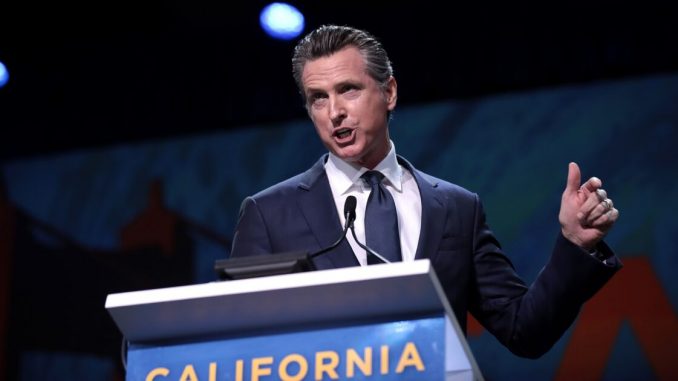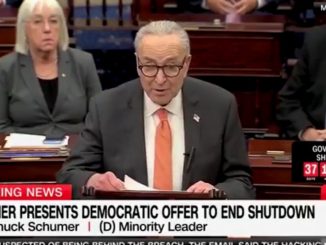
Published October 27, 2025
The “Power-Hungry” Shadow of 2028
When California Governor Gavin Newsom said he’ll “start thinking” about running for president after the 2026 midterms, critics heard something very different — that he’s already running, just waiting for the right moment to make it official. To many on the right, this was less a confession than a confirmation: Newsom’s ambitions have been obvious for years.
A Familiar Playbook
Conservative media immediately seized on the remarks as evidence that Newsom has been laying groundwork under the guise of governance. The Gateway Pundit described him as a “power-hungry” politician eyeing Washington even as California grapples with chronic homelessness, high crime, and rising costs of living. From that perspective, his “fate will determine that” comment isn’t humility — it’s a calculated way to keep national attention without facing immediate scrutiny.
California as a Warning Label
For right-leaning audiences, California under Newsom is the cautionary tale. The state’s housing crisis, exodus of businesses, and ballooning social spending serve as talking points against his leadership model. If a Newsom 2028 campaign were to materialize, Republicans could easily frame it as a referendum on California’s failures — and an omen of what a “Newsom America” might look like.
The Optics Game
Fox News noted how Newsom has spent more time in national interviews and early primary states, despite insisting he’s not campaigning. To conservatives, that signals the same overconfidence that dogged other progressive figures — a politician convinced the media will shield him from accountability while ordinary citizens see their quality of life decline. The optics are simple: the governor of a troubled state acting like a man auditioning for a promotion.
The Culture War Candidate
On social and moral issues, Newsom has become a symbol of progressive excess — sanctuary-state policies, gender legislation in schools, and aggressive environmental mandates. Each of those policies plays well with his base but fuels the right’s portrayal of him as out of touch with middle America. If he enters the 2028 race, expect conservative commentators to paint him as the embodiment of the “California model” — a blend of big government, elite virtue-signaling, and economic decay.
Political Arithmetic
From a strategic standpoint, conservatives see opportunity. Newsom’s national ambitions could revive voter focus on California’s problems just as the GOP looks to rebuild its post-2024 identity. His record gives Republicans an easy contrast candidate — charismatic, well-spoken, and deeply flawed in execution. The phrase “California values” will likely become a shorthand for everything the right wants to reject.
The California Cautionary Tale Deepens
Critics argue that Gavin Newsom’s presidential ambitions should be weighed against his record governing California — a state once seen as a model of prosperity now struggling under the weight of mismanagement. According to California Senate Republicans, a pattern of failure defines his tenure across nearly every major policy front.
10. Homelessness
Despite spending over $20 billion in taxpayer money, California remains home to the nation’s largest homeless population. Encampments continue to grow across Los Angeles, San Francisco, and Sacramento — a visible symbol of failed social policies under Newsom’s watch.
9. Drought and Water Mismanagement
California’s farms face crippling drought conditions. While “atmospheric river” storms bring heavy rainfall, inadequate storage and infrastructure mean that precious water goes to waste. Farmers, who feed much of the country, say they have received “not one extra drop” under Newsom’s leadership.
8. High Gas Prices
Ironically, the heir to the Getty oil fortune has proposed a “windfall profits tax” on gasoline companies — a policy conservatives argue would further increase gas prices rather than lower them. California already has some of the nation’s highest fuel costs, driving families deeper into financial strain.
7. Early Release of Felons
An executive order made it easier for thousands of convicted felons to qualify for early release, with minimal transparency. The move has fueled conservative criticism that Newsom prioritizes leniency over law and order, endangering communities already dealing with rising crime.
6. Education Failures
Recent state testing revealed that two-thirds of California students failed to meet math standards, while more than half fell short in English proficiency. Despite record education spending, student outcomes continue to slide, leaving parents and teachers frustrated by bureaucratic mismanagement.
5. Businesses Fleeing California
A Stanford Hoover Institution study shows businesses are leaving the state at double the previous rate, citing excessive regulation, high taxes, and energy costs. The exodus of employers means lost jobs, lost tax revenue, and shrinking opportunity for working-class Californians.
4. The EDD Scandal
During COVID-19 lockdowns, the Employment Development Department (EDD) became a symbol of chaos. Amid shutdowns ordered by Newsom himself, the agency lost an estimated $33 billion to unemployment fraud — one of the largest cases of financial mismanagement in state history.
3. The French Laundry & NFL Scandals
During the height of COVID restrictions, Newsom attended an exclusive French Laundry dinner and partied maskless in an NFL luxury suite, all while urging Californians to stay home. For many, these incidents crystallized the hypocrisy of California’s elite class — “rules for thee, but not for me.”
2. Wildfire Prevention Failures
An NPR and CapRadio investigation found Newsom overstated wildfire prevention achievements by 690%. While he claimed 90,000 acres had been treated under his executive order, state data showed only 11,399 acres — a massive discrepancy that undercut his credibility on environmental leadership.
1. The High-Speed Rail Debacle
Once denounced by Newsom as a “massive public works failure,” the California High-Speed Rail project continues to drain billions. Despite promising to scale it back, his administration has quietly revived and expanded funding — turning a political embarrassment into an ongoing taxpayer liability.
Why It Matters Nationally
Each of these crises offers conservatives a clear narrative for 2028: if Newsom brings California’s policies to Washington, America could see the same mix of ambition, bureaucracy, and financial recklessness on a national scale.
From homelessness to education to energy, his record reads less like a resume and more like a roadmap for government overreach. Conservatives argue that California’s decline isn’t a coincidence — it’s the direct result of progressive priorities unchecked by accountability.
In the end, as right-leaning analysts see it, Gavin Newsom’s story isn’t about leadership but legacy — a polished image built on crumbling foundations. And if he runs for president, California’s problems will follow him onto every debate stage in America.

Newsom’s comment is the clearest indication thus far that the firebrand Democrat, and staunch political enemy of the Trump administration, has his eyes on the Oval Office in 2028

California Governor Gavin Newsom and his wife, Jennifer Siebel Newsom, attend a black-tie dinner in the State Dining Room of the White House in Washington, DC
 Implications of Gavin Newsom’s 2028 Ambitions:
Implications of Gavin Newsom’s 2028 Ambitions:
1. California as a National Cautionary Tale
Newsom’s potential presidential run puts the spotlight on California’s ongoing crises — homelessness, rising crime, energy shortages, and skyrocketing housing costs. To conservatives, this serves as a living example of what progressive governance looks like in practice. Every policy success he touts is offset by tangible failures that resonate with voters outside the West Coast. The message is simple: electing Newsom nationally could import California’s problems to the rest of the country.
-
Talking Point: “California values” can become shorthand for high taxes, overregulation, and public safety neglect.
-
Political Strategy: Republicans can tie Newsom’s national ambitions directly to the state’s perceived decline, framing his leadership as aspirational for the elite, but disastrous for everyday Americans.
2. Early Media and Fundraising Advantages Signal Elite Alignment
Newsom has already increased his national media presence and is visiting key early primary states, signaling he’s quietly building a campaign infrastructure. Right-leaning observers can interpret this as a strategic play by an established political elite: leveraging media coverage and donor networks while projecting an image of reluctant ambition.
-
Implication: While progressives may applaud his visibility, conservatives see a pattern: a politician who thrives on optics and influence rather than measurable results.
-
Consequence: This early positioning could galvanize conservative donors and grassroots networks to counteract what they view as an elite-driven campaign.
3. Clear Contrast Candidate for Republicans
Newsom’s record on social issues, climate mandates, and economic management provides conservatives with a ready-made contrast candidate. His policies appeal to progressive urban voters but alienate rural, suburban, and middle-America constituencies.
-
Messaging Angle: Republicans can highlight the disconnect between Newsom’s rhetoric and real-world outcomes — promising equality and sustainability while his state experiences housing shortages, high inflation, and mass exodus.
-
Electoral Strategy: Focus on local failures as national warnings, positioning Newsom as out of touch with the everyday struggles of the average American family.
4. Messaging Weaknesses Exposed
Newsom often emphasizes charisma, media-savvy messaging, and ideological vision over practical solutions. Conservatives can frame this as a pattern of style over substance, appealing to emotion and media perception rather than concrete governance.
-
Talking Point: “Polished speeches, poor results.”
-
Political Opportunity: Amplify the contrast between Newsom’s presentation and tangible state outcomes to question whether he can deliver results nationally.
5. Electoral Vulnerabilities Outside Blue States
While Newsom is popular in California’s progressive strongholds, his policies are likely to face skepticism in swing states and conservative-leaning regions. His record may energize opposition among voters who see California as a cautionary tale of what a national Newsom administration might look like.
-
Implication: Right-leaning strategists can target these regions with ads, messaging, and debate questions designed to highlight California’s crises under Newsom’s leadership.
-
Outcome: This positions Republicans to not only defend vulnerable states but also to frame Newsom as a “coastal elite” disconnected from everyday Americans.
6. Catalyst for Republican Unity
Newsom’s candidacy could unify the GOP around a single narrative: his policies and governance style are emblematic of the national Democratic platform they want to challenge. Conservatives could leverage this unity to sharpen messaging, consolidate fundraising, and mobilize grassroots efforts.
-
Narrative: Newsom’s rise isn’t just a personal ambition; it’s a blueprint of what progressives envision for the country — and a rallying point for opposition.
-
Strategic Advantage: A polarizing candidate like Newsom allows Republicans to define the election debate early, forcing Democrats to defend both his record and their broader agenda.
7. Policy Implications and National Debate
From a conservative perspective, Newsom’s national ambitions put several policy issues into focus:
-
Economic Policy: High taxes, housing regulation, and energy mandates can be framed as unsustainable experiments with national consequences.
-
Social Policy: Education mandates, sanctuary policies, and progressive social reforms can be portrayed as culturally alien to Middle America.
-
Federalism and State Models: Newsom’s California becomes the example of what happens when state-level policies are extrapolated nationally.
8. Long-Term Strategic Implications
-
Newsom’s ambitions could reshape the Democratic primary field, forcing other candidates to stake positions relative to him.
-
For conservatives, this creates opportunities to define the ideological battlefield before the general election, framing Newsom not as an innovator but as a cautionary tale.
-
Messaging about accountability, governance, and results versus rhetoric can dominate right-leaning discourse for years leading to 2028.
 Overall Takeaway:
Overall Takeaway:
In the end, Gavin Newsom’s flirtation with a 2028 presidential run isn’t about public service — it’s about positioning. To many Americans, especially those watching California’s decline from afar, he represents the polished face of a failing experiment: big promises, bigger bureaucracy, and little accountability.
If this is the future the Democratic Party wants to sell, conservatives will have no trouble drawing the contrast. The more Newsom talks about leadership, the more his own state reminds voters what that really looks like in practice — soaring taxes, crumbling cities, and a widening gap between rhetoric and reality.
When the cameras roll and the campaign banners go up, the right won’t need to invent a narrative. California under Gavin Newsom is already the story.
SOURCES: THE GATEWAY PUNDIT – Power-Hungry California Governor Says He’s “Thinking About” 2028 Presidential Run After Wrecking His Own State
FOX NEWS – Gov. Gavin Newsom reveals when he’ll start thinking about a potential 2028 run
DAILYMAIL ONLINE – Gavin Newsom confirms his presidential ambitions for 2028
THE TELEGRAPH – Gavin Newsom hints at 2028 White House run





Be the first to comment